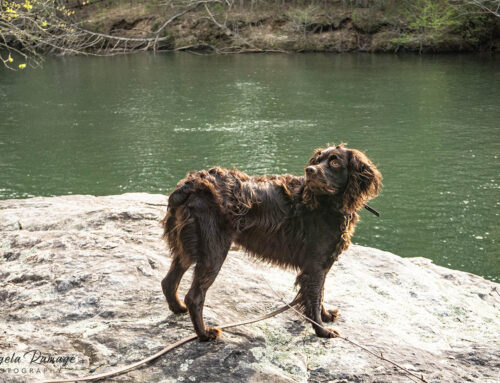On Don’t adjust the color on your computer screen! Theses mountains really have a blue cast over them. I explain below.
Don’t adjust the color on your computer screen! Theses mountains really have a blue cast over them. I explain below.
But first: I’ve just finished my seventh chemo treatment and here we are on top of Albert Mountain at the base of the fire tower. Wessy easily zoomed up and we followed behind. Lots of fun on the Saturday after treatment when the steroids were still running through my body. This is still an easy hike for me. Not too sure how long that will last but for now we are hiking. It’s a short hike but it is “up” an incline. We hop on the Appalachian Trail in the middle of a longer hike from Moody Gap. So, we are only hiking about a mile in and a mile out. Enough for some good exercise and enough to stretch a Boykin’s legs.
I even climbed the fire tower at the top of the mountain. The challenge is worth the hike up!
Here’s the trail and how it looks now. Years ago it was much broader and I guess it still is in the winter when the foliage is gone. It is pretty much a straight up climb until you get near the top and then it levels off. There is a rocky area that is slick when the rocks are wet.
Here’s Anne enjoying the AT on the way to the top! You can see why the Appalachian Trail is called “the green tunnel,” especially in the summer, views are limited as they were on this hike until we got to the top and climbed the tower. Then we could see plenty of the Blue Ridge Mountains.
I had a little bit of a problem with Wessy on this hike. There were lots of good sniffs and maybe a bear or two. She kept going ahead and then stopping to peek back at me. I had to buzz her back using her e-collar a lot.
My favorite: Turk’s Cap. I remember the first time I saw these and how I thought they were so unique and beautiful!
These two! Wessy’s motives were not the purest. Pat has part of a energy bar in her hand and Wessy wanted it!
I’m still pretty crazy over the ferns in the mountains. These seem like ruffles; and actually, I think there are ferns by that name! Such a cool mixture of summer greens.
Here’s the scoop again on the Blue Ridge Mountains. They really are blue! The blue haze that rests over the Blue Ridge Mountains is a familiar sight experienced by travelers worldwide. A 1964 article from The New York Times paints the picture, “The Blue Ridge Mountains, which twist from Pennsylvania to Georgia with as many moods as the sea, display a wide variety of shades—all of them blue. Some summer days, the mountains are a powder blue that is almost gray. Other days, they are robin’s egg blue, or they may be cerulean, turquoise, blue‐black, or purple.” It describes the many ways—over many decades—scientists have tried to determine why the mountains appear blue.
The National Parks Service describes it this way: “The Blue Ridge province is a mountainous belt […] made of highly deformed metamorphic rocks of largely Precambrian ages. These include schists, gneisses, slates, and quartzites, and are extensively intruded by igneous bodies.”
The truth is I don’t think you can ever get tired of the Blue Ridge Mountains. They are ever changing. Another good thing about the mountains that are so near me is that they are probably ten degrees cooler. This means on hot days, you can drive a little further north where the summer temperatures are much more moderate. In the winter months, you just add another layer!
So the final words about the colors of blue: The region is covered with many species of plants and is blanketed by thick forests, making it a very biologically diverse area. It’s certainly a sight to see along with the region’s telltale hue of blue which was a mystery for a long time. But . . .
“The amazing amount of vegetation in the Blue Ridge Mountains, especially the conifers, release what are called Volatile Organic Compounds. VOCs are organic chemicals that easily form vapors at normal temperatures and pressures. The classes of VOCs called terpenes are naturally occurring hydrocarbons emitted by conifers. In the wild and in large numbers, all of those tiny molecules react with natural ozone molecules already in the air to form new particles and scatter blue light from the sun.” Light scattering creates the bluish haze the eye detects over the mountains. So, there you have it! Mystery solved!!
It is all those trees and plants that cause life in the mountains to have a beautiful blue cast that we have come to know and love.














Leave A Comment